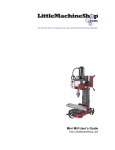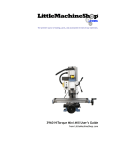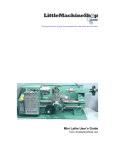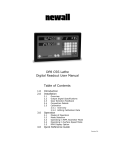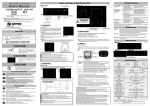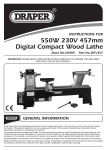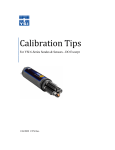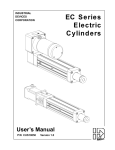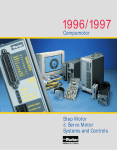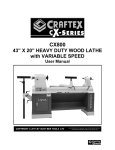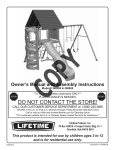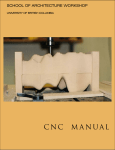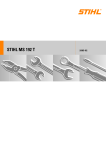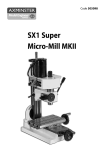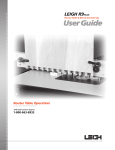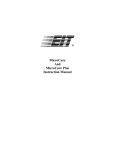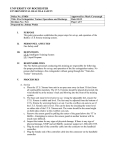Download HiTorque Bench Lathe User`s Guide
Transcript
The premier source of tooling, parts, and accessories for bench top machinists. HiTorque Bench Lathe User’s Guide Model 3536 8.5"×16" • Model 3540 8.5"×20" from LittleMachineShop.com © Copyright 2013 LittleMachineShop.com All rights reserved. Photos © Copyright 2013 PhotoBoost.com All rights reserved. Written by Chris Wood of LittleMachineShop.com Revision 1 LittleMachineShop.com http://www.littlemachineshop.com 396 W. Washington Blvd. #500, Pasadena, CA 91103 (800) 981-9663 • [email protected] 2 Contents Introduction ................................................................................5 Specifications ..............................................................................5 Safety Considerations .....................................................................5 General Safety...........................................................................5 Lathe Safety .............................................................................6 Electrical Safety.........................................................................6 Machine Safety ..........................................................................6 Features .....................................................................................8 Front View ...............................................................................8 Accessories .................................................................................9 Cleaning .....................................................................................9 Mounting Your Lathe .................................................................... 10 Lathe Controls ............................................................................ 10 Motor Controls ......................................................................... 11 Carriage and Cross Feed Controls .................................................. 13 Tailstock Controls ..................................................................... 15 Adjustments .............................................................................. 15 Carriage ................................................................................ 15 Cross Slide Gib ......................................................................... 17 Cross Slide Nut ........................................................................ 17 Compound Rest Gib ................................................................... 17 Compound Rest Nut ................................................................... 18 Apron Position ......................................................................... 18 Tailstock Position ..................................................................... 19 Half Nuts ............................................................................... 20 Drive Belt............................................................................... 21 Maintenance .............................................................................. 21 Cleaning ................................................................................ 21 Lubrication ............................................................................. 21 Chuck ...................................................................................... 23 Changing Chuck Jaws ................................................................. 23 Mounting Work in a 3-Jaw Chuck ................................................... 24 Tool Bits ................................................................................... 24 Grinding Tool Bits ..................................................................... 26 Adjusting Tool Bit Height ............................................................ 26 Turning .................................................................................... 27 Manual Turning ........................................................................ 27 3 Turning with Power Feed ............................................................ 28 Facing ..................................................................................... 29 Facing with Power Feed .............................................................. 29 Turning Angles ........................................................................... 30 Threading ................................................................................. 30 Change Gears .......................................................................... 31 Change Gear Tables .................................................................. 33 Making Left Hand Threads ........................................................... 34 Tool Bit ................................................................................. 34 Compound Angle ...................................................................... 34 Setting the Cutting Tool ............................................................. 35 Threading Process..................................................................... 36 Common Accessories .................................................................... 36 Quick Change Tool Post .............................................................. 36 Indexable Turning Tools .............................................................. 37 4-Jaw Chuck ........................................................................... 38 Faceplate............................................................................... 38 Live and Dead Centers ............................................................... 39 Steady Rest and Follower Rest ...................................................... 39 Parts Diagram 1 .......................................................................... 41 Parts Diagram 2 .......................................................................... 42 Parts List .................................................................................. 43 Wiring Diagram ........................................................................... 48 4 Introduction This user’s guide covers care and operation of the LittleMachineShop.com HiTorque Bench Lathe. Be sure to read and understand the safety guidelines presented in this book before using your lathe. Specifications Swing over bed 8.5" (215 mm) Swing over saddle 4.6" (118 mm) Between centers Model 3536: 16" (410 mm) Model 3540: 20" (510 mm) Spindle taper Morse taper 3 Tailstock taper Morse taper 2 Spindle bore 0.8" (20 mm) Cross slide travel 3.9" (100 mm) Compound rest travel 2.8" (70 mm) Spindle speed 100–2000 RPM Longitudinal feed rates 0.002" (0.045 mm)/ revolution 0.005" (0.126 mm)/ revolution Cross slide feed rates 0.0008" (0.019 mm)/ revolution 0.002" (0.048 mm)/ revolution Range of threads 7-80 TPI (0.25-3.5 mm) Power requirements 120 V 60 Hz 12 Amps Spindle Motor Output 1.34 hp (1000 Watts) Safety Considerations Always use common sense when using a power tool. Besides the general safety rules for any power tool, following also are specific considerations for the bench lathe. General Safety Use common sense. Think through the results of your actions before you act. Understand the operation of the machine. Do not operate the machine if you do not know what is going to happen. Learn, don’t experiment. Study, understand, and do things where you have a clear expectation of the outcome. Don’t “see what will happen.” 5 You are responsible for your own actions. We can’t be held responsible for your actions when you use the machine. Lathe Safety Your bench lathe is a small lathe. Don’t attempt jobs that are beyond its capacity. Check the work piece after you place it in the chuck or other work holding device. Be sure it is secure before turning on the lathe. Don’t wear loose clothing or jewelry when operating the lathe. Stop the spindle and make sure the machine is in a safe condition before: o Opening or removing safety shields o o o o o Reaching into work area Changing or adjusting tools Changing or adjusting work pieces Changing speed ranges Clearing chips or coolant Inspect cutting tools for sharpness, chips, and cracks before each use. Replace dull, chipped, or cracked cutting tools immediately. Handle cutting tools with care. Cutting edges are very sharp and can cause lacerations. Do not use unbalanced work pieces or fixtures in the spindle Remove all tools (wrenches, chuck keys, locking pins, and so on) from the spindle immediately after using them. Electrical Safety Plug the machine into a grounded receptacle. Ensure that all components are properly grounded. The easiest way to ensure this is to plug your machines and devices into grounded outlets that you have tested. Use caution when using liquids and electricity. Ensure that coolants and lubricants are kept away from high voltage electrical components. Disconnect all components from the power receptacle before servicing. In the event of a power outage, turn off all components to ensure that the machine does not restart unexpectedly. Machine Safety Keep bystanders, children, and visitors a safe distance away while operating any power tool. 6 Read the manual. Know the operation of every control before you attempt any operation of the machine. Make sure that all guards are in place and functioning before operating the machine. Check for damage and abnormal wear before operating the machine. Always wear safety glasses (side shields are recommended) that are ANSI Z87.1-2003 compliant. Wear hearing protection (ear plugs or ear muffs) when operating loud machines. Wear appropriate clothing; no rings, gloves, neckties, jewelry, or loosefitting garments. Bind long hair or wear a hat. Do not use compressed air for cleaning machines. A shop vacuum works well and is much safer. Don’t operate machinery while under the influence of drugs or alcohol. Ensure that your machines are well lit. Ensure that your shop is well lit, and have additional task lighting where appropriate. Maintain a clean and uncluttered work area. Avoid pinch points. Never leave a running machine unattended. Do not force or overload machinery. Use appropriate cutting tools with appropriate feeds and speed. Cutting tools get hot during use and can cause burns if handled inappropriately. Do not attempt to use work pieces that are too large or two heavy for the machine. Maintain your machines. Ensure that it is well-adjusted and in a safe state. Clear chips with a brush or other tool, never with your hands or with compressed air. Make sure the machine is on a flat, level surface that is capable of supporting the weight of the machine plus fixtures, vise, and work piece. Clamp work securely. Cutting forces are significant and can turn work pieces that are not secured into projectiles. Be aware that chips and dust from some materials (magnesium, for example) are flammable. Understand the materials you are using. 7 Features Front View 1 2 3 4 5 9 6 7 10 1. Motor controls (for details, see “Motor Controls” on page 11) 2. Headstock 3. Chuck 4. Carriage 5. Cross slide 6. Tool post 7. Compound rest 8 11 12 8. Tailstock (for details, see “Tailstock Controls” on page 15) 9. Change gear cover 10. Bed ways 11. Apron (for details, see “Carriage and Cross Feed Controls” on page 13) 12. Lead screw 8 Accessories The following accessories come with the HiTorque Bench Lathe. Chuck key for the 3-jaw chuck Hex wrenches: 3, 4, 5, and 6 mm Outside jaws for the 3-jaw chuck (for details, see “Changing Chuck Jaws” on page 23) Open end wrenches: 8 x 10 mm, 14 x 17 mm, and 17 x 19 mm #3 Morse taper Dead center Change gears (for details, see “Threading” on page 30) #2 Morse taper Dead center Mounting bolts and washers Cleaning Your lathe will arrive coated with grease to protect it from corrosion during shipment. Follow this procedure to remove the grease: 1. Wipe most of the grease off with rags or paper towels. 2. Clean the surfaces with mineral spirits (paint thinner). 3. Coat the surfaces with oil. See “Lubrication” on page 21 for specific recommendations for lubricants. 9 Mounting Your Lathe Many people purchase a stand or drip tray for the HiTorque Bench Lathe. The machine bolts right to these with the cap screws that are furnished. You might need to unbolt the motor to install the two bolts on the back of the headstock. You can also bolt your lathe to your workbench. The following diagram shows the holes required. Mount the lathe to the workbench with M8 (or 5/16") bolts. Use fender washers on the underside of wooden benches to prevent the bolt heads from pulling through. You might need to unbolt the motor to install the two bolts on the back of the headstock. If you have the drip tray, its mounting dimensions are shown below. Lathe Controls Become familiar with the controls used to operate the lathe before you use the lathe. 10 Motor Controls 5 4 3 6 2 7 8 1 9 10 1. 2. 3. 4. 5. Power switch Emergency stop (E-stop) switch Start button Speed control buttons Spindle speed readout 6. Spindle direction buttons 7. Stop button 8. Spindle disengage knob 9. Fuse holder 10. Power indicator Power Switch The power switch interrupts the input power to the speed control circuit board. Turn the power off when you are not using the lathe. Emergency Stop (E-stop) Switch The red E-stop switch latches in the off position when you press the button. To turn the switch on, turn the knob to the right. Start Button The Start button starts the spindle when the power is on. The spindle runs at the last set speed. Chris’ Tip: The cover over the lathe chuck is interlocked. It must be in the down position for the lathe to run. If you press the Start button and nothing happens it’s most likely that the chuck guard is up. 11 Speed Control Buttons The speed control buttons adjust the spindle speed. Press the up arrow to increase the spindle speed. Press the down arrow to slow the spindle. Spindle Speed Readout The spindle speed readout shows the speed of the spindle in revolutions per minute (RPM). Spindle Direction Buttons The spindle direction buttons control the direction the spindle turns. Press the top button for normal turning. Press the bottom button to run the lathe in reverse. You can change the motor direction at any time and at any speed that safety allows. The motor will make a controlled change of direction. Stop Button The Stop button stops the spindle. Use this button for normal operation of the lathe. Spindle Disengage Knob The spindle disengage knob disengages the spindle from the drive system. Turn the knob to the left to engage the spindle. It is usually used when a mill head is mounted on the lathe so the lathe chuck is not turning during milling. Using the Motor Controls Use the motor controls to turn the spindle. To 1. 2. 3. power up the lathe: Turn the E-stop button to the right to ensure that it is in the on position. Press the top half of the power switch. The green power indicator lights and the spindle speed readout illuminates. To start the lathe: 1. Press the green Start button. 2. Press a direction control button if the spindle is not turning the direction you want. 3. Use the speed control buttons to adjust the spindle speed. To stop the lathe: Press the red Stop button. To stop the lathe in an emergency: Press the red E-stop button. 12 Carriage and Cross Feed Controls You can power the carriage, you can power the cross feed, and you can thread with the HiTorque Bench Lathe. 3 4 5 2 1 1. 2. 3. 4. 5. Carriage hand wheel Cross slide feed handle Compound rest feed handle Half nut lever Power feed lever Carriage Hand Wheel The carriage hand wheel moves the carriage toward or away from the headstock, depending on which way it is turned. Use this hand wheel to position the carriage. Because this hand wheel moves the carriage quickly it is not easy to use this hand wheel to move the carriage while you are turning. Pull the hand wheel towards you to disengage it when you are using power feed. Cross Slide Feed Handle The cross slide feed handle moves the cross slide in and out. Use this handle to advance the tool into the work and for facing cuts. The dial on this handle indicates the relative position of the cross slide. The graduated dial can be repositioned for convenience. There are 50 divisions on the dial. Each turn of the handle advances the cross slide 0.050". 13 Compound Rest Feed Handle The compound rest feed handle advances or retracts the compound rest. Use this handle to advance the tool into the work. The dial on this handle indicates the relative position of the compound rest. The graduated dial can be repositioned for convenience. There are 50 divisions on the dial. Each turn of the handle advances the cross slide 0.050". Compound Rest Rotation The compound rest rotates on the cross slide and you can position it at any angle. Position the compound rest so it moves parallel to the ways to make precise facing cuts. Position the compound rest at 29.5 degrees for cutting standard threads. To change the angle of the compound rest: 1. Loosen the two socket head cap screws along the sides of the compound rest. 2. Turn the compound rest to the desired angle. Chris’ Tip: You may need to remove one of the compound rest hold-down nuts to turn the compound past it. 3. Tighten the two socket head cap screws. Chris’ Tip: For accurate work, use a protractor between the compound rest and the cross slide. Don’t depend on the markings on the side of the compound rest. Half Nut Lever The half nut lever locks the half nuts around the lead screw, which engages the carriage drive for threading. The half nuts are engaged when this lever is down, and disengaged when this lever is to the right. Chris’ Tip: Don’t try to engage the half nuts when the power feed is engaged. There’s an interlock, but you can break it if you try. You’ll find it easier to engage or disengage the half nuts while the lathe is running. If you do attempt to change when the lathe is stopped, don’t force it. Power Feed Lever The power feed lever engages the carriage drive when it is down, and the cross slide drive when it is up. Power feed is disengaged in the middle position. Push the lever to the left before moving it up or down. Chris’ Tip: Don’t try to engage the power feed when the half nuts are engaged. There’s an interlock, but you can break it if you try. 14 You’ll find it easier to engage or disengage the half nuts while the lathe is running. If you do attempt to change when the lathe is stopped, don’t force it. Tailstock Controls Use the tailstock for turning between centers. Tailstock Locking Lever The tailstock is locked into position on the ways by the tailstock locking lever on the back of the tailstock. Pull the lever toward you to tighten the tailstock lock. Push the lever back to release the tailstock. Tailstock Quill Hand Wheel The tailstock quill hand wheel moves the tailstock quill in and out. There are (mm) graduations on the top of the quill that show how far it is extended. There are 0.001" graduations on the hand wheel dial. Retract the tailstock quill all the way to remove tools from the taper in the tailstock quill. Tailstock Quill Locking Lever The tailstock quill locking lever keeps the tailstock quill from moving. Use the tailstock quill locking lever to lock the tailstock quill in position when you are turning between centers. Turn the lever clockwise to lock the tailstock quill, and counterclockwise to unlock the tailstock quill. Adjustments Keeping your lathe in adjustment is an ongoing process. You should check all the following adjustments when you set up your lathe and then periodically as you use your lathe. Looseness in the carriage retaining plates or the gibs can cause chatter when you are using the lathe. If you experience chatter, check all these adjustments. Carriage The carriage is held on the ways by retainers with gibs that are bolted to the bottom of the carriage. A gib is a strip of metal placed between the bearing surface of two machine parts to ensure a precision fit and provide adjustment for wear. The bench lathe has gibs in several places, including the carriage. 15 Carriage retainer To 1. 2. 3. 4. 5. 6. 7. 8. adjust the carriage gibs: Loosen the three socket head cap screws on the back bottom of the carriage. Loosen the four lock nuts on the back bottom of the carriage. Slightly loosen all four set screws. Snug each cap screw equally. This will lock the carriage in position. Loosen each cap screw about 1/8 turn to allow carriage to move, but without play. Snug the set screws to lock the cap screws in position. Do not over tighten. While holding the set screws from turning, tighten the lock nuts. Test by moving the carriage. Loosen or tighten all the cap screws the same amount until the carriage moves freely, but without play on the ways. 16 Cross Slide Gib Compound rest gib adjusters Cross slide gib adjusters To 1. 2. 3. 4. 5. 6. adjust the cross slide gib: Loosen the three lock nuts on the side of the cross slide. Slightly loosen all three set screws on the side of the cross slide. Snug each set screw equally. This will lock the cross slide in position. Loosen each set screw 1/8 turn to allow the cross slide to move. While holding the set screws from turning, tighten the lock nuts. Test by turning the handle. Loosen or tighten all the set screws the same amount until the cross slide moves freely, but without play in the dovetail. Cross Slide Nut The cross slide nut is adjustable to remove free play from the cross slide feed screw. The cross slide nut is partially split and set screws adjust the gap to allow adjustment of play in the nut. To adjust the cross slide nut: 1. Move the cross slide as far back as it will go. The screw disengages. 2. Engage the nut and move the cross slide back toward you enough that the nut is fully engaged. 3. Adjust the set screws in the cross slide nut to remove play without making it hard to turn. Compound Rest Gib The compound rest also incorporates a gib for adjustment. 17 To 1. 2. 3. 4. 5. 6. adjust the compound rest gib: Loosen the four lock nuts on the side of the compound rest. Slightly loosen all four set screws on the side of the compound rest. Snug each set screw equally. This will lock the compound rest in position. Loosen each set screw 1/8 turn to allow the compound rest to move. While holding the set screws from turning, tighten the lock nuts. Test by turning the handle. Loosen or tighten all the set screws the same amount until the compound rest moves freely, but without play in the dovetail. Compound Rest Nut The compound rest nut is adjustable to remove free play from the compound rest feed screw. The compound rest nut is partially split and set screws adjust the gap to allow adjustment of play in the nut. To adjust the compound rest nut: 1. Remove the compound rest by removing the two socket head cap screws that lock it from rotating. 2. Turn the compound rest over to access the adjustable nut. 3. Adjust the cap screw in the cross slide nut to remove play without making it hard to turn. 4. Replace the compound rest and the two socket head cap screws. Apron Position The apron is adjustable to center the half nuts horizontally on the lead screw. 18 Apron bolts To adjust the apron position: 1. Loosen the four socket head cap screws that secure the apron to the carriage. There are two on the left side of the carriage and two on the right side of the carriage 2. Engage the half nuts on the lead screw. 3. Tighten the four socket head cap screws. Tailstock Position The tailstock is adjustable from front to rear so you can align it with the spindle. 19 Tailstock adjustment set screw Tailstock locking set screw To 1. 2. 3. 4. 5. 6. 7. 8. adjust the tailstock position: Remove the 3-jaw chuck from the lathe spindle. Put a 3 Morse taper dead center in the spindle. Remove the tailstock from the lathe. Loosen the two small locking set screws. Place the tailstock back on the ways. Put a 2 Morse taper dead center in the tailstock quill. Move the tailstock toward the spindle until the two centers almost touch. Use the tailstock adjustment set screws to move the upper part of the tailstock casting until the centers are aligned. 9. Place a steel rule between the two centers. The length of the rule should be horizontal and the width vertical. Bring the centers together to hold the rule in place. 10. Adjust the upper part of the tailstock casting until the steel rule is perpendicular to the axis of the lathe. If the near end of the rule angles toward the headstock, move the tailstock back. 11. When the tailstock is in the correct position, tighten the tailstock locking set screws. 12. Check the adjustment. Half Nuts The half nut gib takes the play out of the half nut. To adjust the half nut gibs: Tighten the three set screws in the right side of the apron to remove play from the half nuts. 20 Drive Belt The drive belt is a timing belt and should rarely need adjustment. Mounting bolt To 1. 2. 3. 4. adjust the drive belt: Unplug the power cord. Open the change gear cover. Loosen the four motor mounting socket head cap screws. While you push down on the motor pulley inside the change gear cover with your right thumb, tighten one socket head cap screw on the top and one on the bottom of the motor. 5. Tighten the other two socket head cap screws. 6. Close the change gear cover. Maintenance Maintenance of the bench lathe is simple, but important. Regular maintenance will keep your bench lathe working like new for many years. Cleaning The maintenance you perform most often is cleaning. Keeping swarf (chips, shavings, and debris) off of wearing surfaces is the most important thing you can do to prolong the life of your bench lathe. Use a 1" paintbrush to remove swarf from the ways as you work. Clean swarf from the lathe, from top down after each use. Lubrication We recommend the use of two lubricants on your mill. 21 Where oil is required, we recommend Lubriplate 3V Machine Tool Oil. Lubriplate 3V is a 20 weight oil especially designed for machine tool way lubrication and bearing lubrication. Chris’ Tip: Lubriplate 3V Machine Oil is available from LittleMachineShop.com. If you prefer to purchase locally, get Mobil 1 synthetic motor oil, any viscosity, available at most auto parts stores. Where grease is required, we recommend Lubriplate 630-AA Lithium-Based Grease. Lubriplate 630-AA is an NLGI No. 1 lubricant. Lithium grease is a plastic-friendly general use grease that is easy to find and easy to use. Chris’ Tip: Lubriplate 630-AA grease is available from LittleMachineShop.com, but you might have trouble finding it locally. Don’t worry about the brand name. Get white lithium grease. Every auto parts store and most hardware stores have it. The following points on your lathe require lubrication. Location Lubricant Frequency Notes Lathe ways Oil Daily Apply oil to both the front and back ways on both sides of the carriage. Move the carriage back and forth to spread the oil. Lead screw threads Oil Daily Clean swarf (chips, shavings, and debris) daily. Compound rest dovetail Oil Daily Advance the compound rest to the extent of its normal travel. Apply oil to the end of the gib and the ends of the dovetails. Retract the compound rest. Cross slide dovetail Oil Daily Advance the cross slide to the extent of its travel. Apply oil to the end of the gib and the ends of the dovetails. Retract the cross slide. Oil fittings Oil Weekly There are several oil fittings on the lathe. Lubricate each one with one squirt from a pump oiler. Other machined surfaces Oil Weekly Oil lubricates and prevents corrosion. Chuck Oil Monthly Disassemble, clean and lubricate. Wrap with a paper towel, secure with an elastic band, and run lathe to sling out excess oil. 22 Location Lubricant Frequency Notes Change gears Grease Monthly Apply a light coat of grease the change gears each time you change them. Apply grease to the installed gears at least monthly. Change gear B-C shaft and bushing Oil Monthly Oil the B-C shaft and bushing every time you change gears, and at least monthly. Tailstock quill and screw Grease Yearly The spindle bearings are tapered roller bearings that are behind seals and do not require additional lubrication. The countershaft and other bearings are ball bearings that are shielded and do not require additional lubrication. Chuck Changing Chuck Jaws 3-jaw lathe chucks come with two sets of jaws. The “normal” set is called the inside jaws, because the stepped side is designed to fit inside of hollow work pieces and hold by an outward force. In many cases, however, these jaws are used to clamp on the outside of smaller objects using the long straight side. The second set of jaws is called the outside jaws because the stepped side of these jaws is designed to clamp on the outside of larger objects. Because of the construction of a 3-jaw chuck, each of the three jaws in a set is different. You will find a number in the groove in the side of each jaw that identifies its position in the set. 23 To 1. 2. 3. 4. remove a set of chuck jaws: Place a piece of wood on the ways to protect them in case you drop something. Place your right hand around the chuck to prevent the jaws from falling out. With your left hand, turn the lathe chuck key counter clockwise to open the jaws. The jaws will come loose from the chuck, one at a time, when about half the length is exposed beyond the diameter of the chuck. To install a set of chuck jaws: 1. Place the three jaws in numeric order on the bench. 2. Slide jaw number 1 into the slot in the chuck that has the serial number stamped in it. 3. Press the jaw into the slot with one hand, and with the other hand, turn the chuck key to open the chuck. 4. You will feel the jaw move out of the slot as you turn. Stop turning right after the jaw clicks inward in the slot. 5. Turn the chuck key to close the chuck about ¼ turn to engage jaw 1. 6. Slide jaw 2 into the next slot counterclockwise from jaw 1 when you are looking toward the headstock. 7. Slide jaw 3 into the open slot. 8. While pressing jaws 2 and 3 into the slots, turn the chuck key to close the chuck. Mounting Work in a 3-Jaw Chuck Three jaw lathe chucks are good for most lathe operations. All three jaws move together as you turn the chuck key. But because of the way they are made, 3-jaw chucks have limited accuracy. They will center work to within about 0.003" runout. If you need better concentricity, use an independent 4-jaw chuck or a collet. If you chuck a work piece, create a part, and then part it off, the lack of concentricity will not cause a problem. The only time it is a problem is when you try to re-chuck a work piece. Place your work piece between the jaws of the lathe chuck and turn the chuck key clockwise to close the jaws. Tighten firmly. To get the jaws as tight as possible, tighten all three locations with the chuck key. Tool Bits When you purchase a new lathe tool bit, it might have an angle on the end, but it is not properly sharpened for turning. Grinding lathe tool bits is a bit of an art. It takes some practice to get good at it. You need to create a cutting edge that is sharp, extends out so that the cutting edge and not the side of the tool contacts the work, but that still has enough support to maintain sufficient strength to cut metal. 24 Before diving in, there are some terms you need to understand. The illustration below shows these terms. First, notice that there are two cutting edges on the tool bit. There is a cutting edge on the end of the tool bit called the front cutting edge. There is also a cutting edge on the side of the tool. Between these cutting edges is a rounded section of cutting edge called the nose. Side cutting edge The side cutting edge does most of the cutting. As the tool bit moves along the work piece the side cutting edge removes most of the material. Front cutting edge The front cutting edge cuts when the tool is advanced into the work. Nose The nose is a critical part of the cutting edge, because it produces the surface finish of the work piece. Side rake The side rake produces the side cutting edge that cuts into the work piece. Side relief Side relief provides clearance for the side cutting edge. Without side relief, the side of the tool bit would hit the work piece and not allow the cutting edge to penetrate the work piece. Back rake The back rake produces the front cutting edge that cuts into the work piece. 25 Front relief Front relieve provides clearance for the front cutting edge. Without front relief, the front of the tool bit would hit the work piece and not allow the cutting edge to penetrate the work piece. Grinding Tool Bits Use a bench grinder to sharpen your tool bits. Even an inexpensive bench grinder can do a good job grinding lathe tool bits. In some cases, you might want to purchase a higher quality fine grit wheel. Keep a small cup of water near your grinder. Grinding generates heat, which can cause two problems. The tool bit will become too hot to hold. Overheating can also affect the heat treatment of the tool bit, leaving the cutting edge soft. Use a protractor to measure the angles. They are not super-critical, but you should try to stay within one degree of the recommendations. Grind the Front Relief The first step in creating a tool bit is to grind the front relief. For most work, a relief angle of 10° works well. While you are grinding the front relief, you are also creating the front cutting edge angle. Make this angle about 10° also, so that the corner formed by the front cutting edge and the side cutting edge is less than 90°. Grind the Left Side Relief Form the left side relief next. Again, create about a 10° angle. You don’t need to form a side cutting angle. The side cutting edge can be parallel to the side of the tool blank. Grind the Top Rake The top of the tool bit is ground at an angle that combines the back rake and the side rake. The side rake is most important, because the side cutting edge does most of the work. For cutting steel and aluminum, the side rake should be about 12° and the back rake should be about 8°. For cutting brass, the rake angles should be much less, or even 0°. Round the Nose A small nose radius allows you to turn into tight corners. A large nose radius produces better surface finishes. Create a nose radius that is appropriate for the tool bit you are creating. Adjusting Tool Bit Height The cutting edge of the tool bit should almost always be set to the center height of the lathe spindle. 26 There are several methods for checking the height of the tool bit. Perhaps the simplest way is to place a thin strip of metal, such as a steel rule or feeler gage, between the work piece and the point of the tool bit. If the height is correct, the strip of metal will be held vertical. If the top is leaning toward you, the tool bit is too low. If the top is leaning away from you, the tool bit is too high. Using the standard tool post, you adjust the tool bit height using shims under the tool bit. You can get an economical set of shims, about the right size, at any auto parts store. Purchase a set of feeler gages and remove the pivot pin. Chris’ Tip: The easy way to adjust the tool bit height is to get a quick change tool post. Virtually all quick change tool posts incorporate a mechanism for easily adjusting the tool bit height. Turning The most common use of a lathe is turning down the diameter of a work piece. Manual Turning Follow these steps to turn the outside diameter of a work piece. To turn manually: 1. Put a tool bit in the tool holder and adjust the cutting edge to center height. 2. Angle the tool so that the front cutting edge forms an acute angle with the axis of the work piece, as shown in the illustration below. 27 3. Move the carriage so that the tool bit is near the right end of the work piece. 4. Turn the lathe on. Adjust the speed to an appropriate speed for the material and diameter you are working on. The LittleMachineShop.com Web site has a calculator to help you determine appropriate cutting speeds at http://littlemachineshop.com/Reference/CuttingSpeeds.php. 5. Using the cross slide feed handle, slowly advance the tool bit into the work until it just touches the surface of the work piece. 6. Move the carriage to the right so that the tool bit is past the end of the work piece. 7. Using the cross slide feed handle, advance the tool bit about 0.010". 8. Using the carriage hand wheel, move the carriage slowly to the left. As the tool bit meets the work piece, it starts cutting. Turning with Power Feed The bench lathe incorporates a power carriage feed that can move the carriage. Change gears for turning There are two options for turning. Use the finer feed for finish turning and the coarser feed for roughing cuts. The bench lathes are shipped with the gears set for finish turning. Feed per Spindle Revolution A B C D 0.0018" (0.045 mm) 30 120 60 120 0.0049" (0.126 mm) 50 100 70 100 To learn how to change the gears, see “Change Gears” on page 31. To turn with power feed: 1. Put a tool bit in the tool holder and adjust the cutting edge to center height. 2. Angle the tool so that the front cutting edge forms an acute angle with the axis of the work piece, as shown in the illustration above. 3. Move the carriage so that the tool bit is near the right end of the work piece. 4. Turn the lathe on. Adjust the speed to an appropriate speed for the material and diameter you are working on. The LittleMachineShop.com Web site has a calculator to help you determine appropriate cutting speeds at http://littlemachineshop.com/Reference/CuttingSpeeds.php. 5. Using the cross slide feed handle, slowly advance the tool bit into the work until it just touches the surface of the work piece. 6. Move the carriage to the right so that the tool bit is past the end of the work piece. 7. Using the cross slide feed handle, advance the tool bit about 0.010". 8. Push left and then down on the power feed lever until the power feed engages. As the tool bit meets the work piece, it starts cutting. 28 9. When the carriage has moved as far as you want, raise the power feed lever to disengage the power feed. The carriage stops. Facing Facing is cutting on the end (or face) of the work piece. To face a work piece: 1. Put a tool bit in the tool holder and adjust the cutting edge to center height. 2. Angle the tool so that the side cutting edge forms an acute angle with the face of the work piece. 3. Move the carriage to the right so that the tool bit is past the right end of the work piece. 4. Ensure that the power feed lever is in the middle (disengaged) position. 5. Push down on the power feed lever until the half nuts engage. You might have to move the carriage slightly so the half nuts will engage. 6. Turn the lathe on. Adjust the speed to an appropriate speed for the material and diameter you are working on. The LittleMachineShop.com Web site has a calculator to help you determine appropriate cutting speeds at http://littlemachineshop.com/Reference/CuttingSpeeds.php. 7. Using the compound rest feed handle, slowly advance the tool bit into the work until it just touches the surface of the work piece. 8. Move the cross slide back so that the tool bit is clear of the diameter of the work piece. 9. Using the compound rest feed handle, advance the tool bit about 0.005". 10. Using the cross slide feed handle, advance the cross slide slowly. As the tool bit meets the work piece, it starts cutting. 11. Continue advancing the cross slide until the tool bit reaches the center. Facing with Power Feed The bench lathe incorporates a power cross feed that can move the cross slide. The change gear settings for turning also affect the cross slide speed. The cross slide moves at a little under half the speed of the carriage. To face with power feed: 1. Put a tool bit in the tool holder and adjust the cutting edge to center height. 2. Angle the tool so that the side cutting edge forms an acute angle with the face of the work piece. 3. Move the carriage to the right so that the tool bit is past the right end of the work piece. 4. Turn the lathe on. Adjust the speed to an appropriate speed for the material and diameter you are working on. The LittleMachineShop.com Web site has a 29 5. 6. 7. 8. 9. calculator to help you determine appropriate cutting speeds at http://littlemachineshop.com/Reference/CuttingSpeeds.php. Using the compound rest feed handle, slowly advance the tool bit into the work until it just touches the surface of the work piece. Move the cross slide back so that the tool bit is clear of the diameter of the work piece. Using the compound rest feed handle, advance the tool bit about 0.005". Push left and then up on the power feed lever until the power feed engages. As the tool bit meets the work piece, it starts cutting. When the cross slide has moved as far as you want, lower the power feed lever to disengage power feed. The cross slide stops. Turning Angles There are several methods of turning angles or tapers. For large angles of short length, such as a chamfer, turn the compound rest to the angle you want. Advance the tool across the work with the compound rest, and advance the tool into the work with the cross slide or the carriage. You can use the same method for small angles (usually called tapers) of a length less than the compound rest travel. For longer tapers, the work is usually placed between centers with the tail center offset from the centerline of the lathe. Chamfer Taper Threading Much of the mechanism of your lathe is provided to allow you to cut threads. Your lathe can cut a broad range of thread pitches. In fact, with the standard change gears, you can cut many more thread pitches than those shown on the table on the lathe. 30 Change Gears The series of gears that drive the lead screw are called change gears because you change them to turn different thread pitches. There are 4 positions for the change gears, commonly called A, B, C and D. A This is the top change gear position. It is forward of and slightly below the spindle. B Gear positions B and C are on the same shaft, between positions A and D. Position B is the inside gear on this shaft. C Gear positions B and C are on the same shaft; between positions A and D. Position C is the outside gear on this shaft. D Position D is the end of the lead screw. 31 The change gears are commonly tight on the shaft when new. You might need to use a screwdriver behind them to pry them off. To change a gear in position A, use an 8 mm end wrench on the square end of the shaft to keep it from turning. Loosen the nut with a 19 mm end wrench and remove the notched washer from behind the nut. Remove the nut so you can slide the gear off the shaft. To change a gear in positions B or C, use an 8 mm end wrench on the square end of the shaft to keep it from turning. Loosen the nut with a 19 mm end wrench and remove the notched washer from behind the nut. Remove the nut so you can slide the gear off the shaft. The B and C gears ride on a sleeve that is free to turn on the shaft. It has a keyway and key that keep the B and C gears turning together. Lubricate this sleeve every time you change a B or C gear. Bad things happen when these sleeves seize on the shaft. To change the gear in position D, use a 17 mm end wrench to remove the shoulder bolt that retains the gear. Gear position D has a spacer behind the gear. When you only use three gears, put the spacer outside the gear so the gear will align with the gear in position B. In the change gear tables, many of the combinations have “Any gear” in columns B and C. This means that you can use a gear with any number of teeth in position B. It is an idler and does not affect the overall gear ratio. Use a gear that makes it easy to properly engage the gears. For these combinations, you can use any gear for position C; this gear acts only as a spacer and does not engage the other gears. The B-C Gear shaft is mounted on an arm that pivots around the lead screw. You can move the B-C shaft location to engage different gear combinations. To engage a new set of gears, use a 5 mm hex wrench to loosen the socket head cap screw that locks the B-C arm around the lead screw. Use an 8 mm end wrench on the square end of 32 the B-C shaft to loosen it in the slot in the arm. Move the gears so they are all in engagement. Tighten the arm around the lead screw and tighten the B-C shaft. Change Gear Tables Inch Threads Pitch 7 8 9 10 11 11.5 12 13 14 16 18 20 24 A 50 50 50 50 50 49 50 50 30 30 30 30 30 B 100 100 100 100 100 94 100 94 120 120 120 120 120 C 127 127 127 127 127 127 127 90 127 127 127 127 127 D 35 40 45 50 55 60 60 49 35 40 45 50 60 Pitch 27 28 32 36 40 44 48 56 64 72 80 A 40 30 30 30 30 35 45 35 35 30 30 B 120 120 120 120 120 100 120 120 127 120 120 C 127 127 127 127 127 70 60 70 87 60 60 D 90 70 80 90 100 85 85 90 120 85 94 D 120 120 120 120 80 120 100 100 120 Pitch 0.8 1 1.25 1.5 1.75 2 2.5 3 3.5 A 50 50 50 45 49 50 50 45 45 B 100 Any Any Any Any Any Any 90 94 C 80 gear gear gear gear gear gear 120 127 D 100 100 80 60 56 50 40 40 35 Metric Threads Pitch 0.25 0.3 0.35 0.4 0.45 0.5 0.6 0.7 0.75 A 30 30 35 40 30 30 30 50 45 B C 120 60 100 60 100 60 100 60 100 60 Any gear Any gear 100 70 Any gear 33 Making Left Hand Threads You can make left hand threads with this lathe by changing one gear. Move the driver gear from the idler shaft to the drive shaft and also swap the spacer. Gears set for right hand threads Gears set for left hand threads Tool Bit For threading, the tool bit is ground to the profile of the thread. For most threads, this is a point with a 60° included angle. The front of the tool should have about 10° of relief. No back rake is used. The left side should have about 8° of relief, and the right side should have about 10° of relief. The tip of the tool should have a flat that is 1/8 of the thread pitch. Compound Angle Set the compound rest at a 29.5° angle from a line perpendicular to the axis of the lathe. This allows you to advance the tool with the compound rest. At this angle the 34 tool cuts only on the left side of the thread form. This helps prevent chatter that might result from cutting the entire V form of the thread at once. Chris’ Tip: Use an accurate protractor when setting the compound rest. The scale on the lathe is not accurate enough. Setting the Cutting Tool Even though the compound rest is set at an angle to the work piece, the thread cutting tool must be set square to the work piece. A center gage makes this setting possible. A center gage has several V-shaped cutouts. They can be used to check the tool bit as you grind it, and to check the angle of the tool with respect to the work piece. To align the tool bit to the work: 1. Ensure that the point of the tool bit is set at the center height of the lathe. 2. Place the center gage between the point of the tool bit and the work piece. Leave enough room so that the center gage can be moved back and forth so you can check each side of the tool bit separately. 3. Align the tool bit to the sides of the V-shaped cutout in the side of the center gage. 35 4. Secure the tool bit in position. 5. Advance the tool bit until the point just makes contact with the work piece. 6. Zero the cross slide dial. Hold the cross slide feed handle and rotate the graduated dial. Threading Process It takes several passes to cut a thread to full depth. You must follow the correct procedure during each pass to ensure the thread is cut correctly. Use the power feed lever to engage the lead screw drive. The carriage should move from right to left (toward the head stock) to cut right-hand threads, or from left to right (away from the head stock) to cut left-hand threads. For each pass in cutting threads: 1. Move the carriage to the beginning of the cut. 2. Advance the cross slide to the initial position. For the first pass, you are already there. For additional passes, advance it 2 complete turns to the 0 mark. 3. Advance the compound rest to move the tool bit into the work. For the first pass, this should be only 0.001". For additional passes, it should be 0.005" to 0.010". 4. Start the lathe. Run it at the lowest speed. 5. Engage the half nuts. 6. When the tool reaches the end of the thread, stop the lathe. 7. Back off the cross slide exactly 2 turns. 8. Run the lathe in reverse back to the beginning of the thread. 9. Repeat steps 2 through 8 until the thread is finished. After you have made the first pass, which should leave just a spiral mark on the work piece, use a thread gage to check that you are cutting the correct number of threads per inch. Use a nut or the matching part to tell when you are done cutting the thread. Common Accessories You will soon find that the purchase of a lathe is just an initial step. There are many tools and accessories that you will need to get full use from your lathe. LittleMachineShop.com carries a full selection of accessories. Following are some common accessories used with the bench lathe, a small sampling of the complete LittleMachineShop.com line. Quick Change Tool Post The standard bench lathe tool post has positions for up to four tools. While this is useful, the standard bench lathe tool post does not have the capability to hold boring bars or cut-off tools without an adapter of some sort. 36 Quick-change tool posts provide several advantages. They provide an easy way to adjust the height of the tool bit. They provide a quick way to change from one tool to the other. They provide a way to hold several different kinds of tools, usually including turning tools, cut-off blades, and boring bars. And they are indexable, meaning that you can remove a tool, and when you replace it, it returns to the same position, with no adjustment necessary. LittleMachineShop.com part number 3048. This is a very high quality quick-change tool post for the HiTorque Bench Lathe. It holds tools up to 3/8" shank. The set includes: Tool post Turning & facing tool holder Boring, turning & facing tool holder Heavy duty boring tool holder Universal parting blade holder Knurling, facing & turning tool holder Indexable Turning Tools Indexable turning tools usually come in a set of five tools, providing a range of cutting angles. These tools use indexable inserts, usually made from carbide, but sometimes from high-speed steel. They are called indexable because you can change an insert and the new insert will take the exact position of the insert it replaces. You can resume work with no further adjustments. Indexable inserts are pre-sharpened. LittleMachineShop.com part number 1669. This set of indexable turning tools includes 5 tools (AR, AL, BR, BL, TE), wrenches, and extra screws. It comes in a fitted case. (The letters designate the angles of the cutting edge.) 37 4-Jaw Chuck The 3-jaw scroll chuck that comes with the bench lathe provides a quick way to clamp round and hexagonal work fairly accurately. A 4-jaw independent chuck provides several advantages over a 3-jaw scroll chuck. It can hold square or rectangular work, as well as round. Work can be centered more accurately because you adjust each jaw independently. It can hold larger work than the same size 3-jaw chuck. You can offset work in a 4-jaw chuck by clamping it off center. LittleMachineShop.com part number 1588. 4 inch, 4-jaw chuck. Each jaw is independently adjustable and reversible. This set includes a chuck key and reversible jaws. The through bore of this chuck is 0.98". The chuck can hold work up to 100 mm (3.94") in diameter. LittleMachineShop.com part number 2338 & 2961. 5 inch, 4-jaw chuck. Each jaw is independently adjustable and reversible. With an appropriate adapter a 5" chuck can be mounted on the bench lathe. This set includes a chuck key and reversible jaws plus an adapter to mount the 5" lathe chuck on the HiTorque Bench Lathe. The through bore of this chuck is 1.18". The chuck can hold work up to 125 mm (4.92") in diameter. Faceplate A faceplate allows you to mount work that can’t be held in a chuck. You can bolt oddshaped work pieces to the faceplate. 38 LittleMachineShop.com part number 3400. Faceplate for the HiTorque Bench Lathe. The faceplate is 7.1" in diameter and has 8 slots for mounting work. LittleMachineShop.com part number 3401. Clamping kit for faceplate. This kit includes clamping bars and fasteners to attach work to the faceplate. Live and Dead Centers A live center goes in the tailstock and is used to support the end of a long work piece; it rotates with the work piece. A dead center goes in the spindle and supports work being turned between two centers. The live center is LittleMachineShop.com part number 1592. It has a 2 Morse taper shank. This center fits the tailstock of the bench lathe. The dead center is LittleMachineShop.com part number 1188. It has a 3 Morse taper shank. This center fits the headstock of the bench lathe. The center has a 60 degree included point angle. Steady Rest and Follower Rest Steady and follower rests support small diameter work that would otherwise flex too much. A steady rest mounts in a fixed position on the ways of the lathe. A follower rest mounts on the carriage and moves with the cutting tool, providing support where it is needed. 39 The steady rest is LittleMachineShop.com part number 3398. The steady rest can support work up to 2.2" in diameter. The follower rest is LittleMachineShop.com part number 3399. 40 Parts Diagram 1 41 Parts Diagram 2 42 Parts List Item 1 2 3 4 5 6 7 7 8 9 10 11 12 14 15 16 17 18 19 20 21 22 23 24 25 26 27 28 29 30 31 32 33 34 35 36 Description Bed Tailstock chuck Tailstock sleeve Leadscrew Flat key Locking axis Handle Handle Adjusting washer Locking sleeve Locking nut Oil pump Tailstock Rivet Leadscrew support Screw M4×20 Scale ring Handle sleeve Handle Spring Long handle Nut Washer Hand wheel Rotating shaft Elastic pin Limit shaft Elastic washer Eccentric sleeve Zero Label Nut M10 Tailstock press plate Tension shaft Base Screw M4×12 Screw M8×14 Qty 1 1 1 1 3 1 1 1 1 1 1 17 1 10 1 4 1 1 1 4 1 1 2 1 1 2 1 1 1 2 1 1 1 1 2 2 Item 37 38 39 40 41 42 43 44 47 48 49 50 51 52 54 55 56 57 58 59 60 61 62 63 64 65 66 67 68 69 70 71 72 73 43 Description Screw M4×10 Screw M6×16 Nut Leadscrew Cooper cover Leadscrew support Screw M6×16 Pin Screw M8×20 Protection cover Green light Fuse Power switch Filter Film Fan power panel Switch panel Screw M3×20 Tapping screw Digital tailgate window Compressing spring PC board glide Button plate Nut Screw M4×8 Electrical operation box Leadscrew connecting sleeve Screw M4×16 Nut M16×1.5 Bearing Leadscrew shaft Thick washer Bolt Transition gear Qty 1 1 1 1 1 1 7 4 2 1 1 1 1 1 1 1 1 4 6 1 4 4 1 4 14 1 1 9 2 2 1 1 1 2 Item 74 75 77 78 79 80 81 82 83 84 85 86 87 88 89 90 91 92 93 94 95 96 97 98 99 100 101 102 103 104 105 107 108 109 110 111 Description Cooper cover I Washer Leadscrew protection cover Screw M4×10 Rack Washer Bolt M8×35 Nut Gear box Leadscrew support Screw M6×35 Transition gear 60T Slipping plate Bolt Washer Nut Screw M5×8 Gear box cover Cover Label Screw M6×10 Washer Nut Elastic washer Screw light finger Screw M4×10 Back plate of gear box Screw M5×25 Nut Screw M8×25 Motor support Elastic pin Motor pulley Washer Pin Qty 1 1 Item 112 113 114 116 117 118 119 120 121 122 123 124 125 126 127 128 129 131 132 133 134 135 136 137 138 139 140 1 17 1 16 6 1 1 1 1 1 1 1 2 2 5 1 1 1 5 6 11 6 8 2 12 141 1 142 143 145 146 147 149 150 151 152 1 4 6 1 1 1 1 1 44 Description Brushless motor Elastic washer Screw M5×20 Compressing spring Screw M6×6 Handle Screw M8×12 Elastic pin Screw M5×16 Positioning disk Screw M4×8 Positioning sleeve Small shaft Flat key Boll shaft Sleeve Cover Timing pulley Elastic washer Transition gear I 42T Washer Ring Timing belt Compressing spring Nut M6 Fixed small shaft Damping set Protection cover support Protection cover Nut Ring Oil seal Bearing Flat key Pin Bolt Change gear Z;30 Qty 1 4 4 4 2 1 1 1 1 1 3 1 1 1 2 1 2 1 2 1 1 1 1 1 2 1 1 1 1 2 1 1 1 1 1 1 1 Item 153 154 155 156 157 158 159 160 161 162 163 164 165 166 167 168 169 170 171 172 173 174 175 176 177 178 179 180 181 182 183 184 185 187 188 189 190 Description Transforming shaft Transition gear II 42T Boll shaft Screw M4×12 Block Fork Elastic ring Block Ring Safety label Dust cover Elastic ring Shaft I Flat key Flat key Flat key Slipping gear 32T Rolling center Spindle Bearing Oil seal Spindle gear 32T Adjusting block Elastic ring Carriage Electrical box side cover Cover Rubber insert Tapping screw Fan Dust net Small cover Screw M3×14 PC board Insert Tapping screw Screw M4×12 Qty 1 1 1 5 1 1 6 1 4 1 1 1 1 2 2 1 1 1 1 1 1 1 1 1 1 Item 191 192 193 194 195 197 198 199 200 201 204 206 207 208 209 210 211 212 213 214 215 216 217 218 219 220 221 222 223 224 225 226 227 228 229 230 231 1 1 1 8 1 1 1 4 1 4 2 2 45 Description Micro switch Micro switch panel Electrical box Pulling off M12 Pulling off M16 Emergency stop switch Screw M5×8 Washer Saddle Press plate Nut Scale ring Bolt Bearing support Rolling ball Bearing Screw M6×25 Pin Screw M4×30 Cover Gib, Cross Slide Screw M3×6 Middle saddle Screw M8×12 Screw M5×30 Screw M6×10 Screw M5×30 Gear 19T leadscrew nut Screw M4×8 Linoleum Protection cover Linoleum Protection cover Screw M3×12 Iron plug Press plate Bridled press plate Qty 1 1 1 1 2 1 1 1 1 2 2 1 2 1 2 4 2 4 1 1 1 1 2 3 2 4 1 1 2 2 2 2 2 8 1 1 1 Item 232 233 234 235 236 237 238 239 240 241 242 243 244 245 246 247 251 252 253 254 255 256 258 259 260 261 262 263 264 265 266 267 268 269 270 271 272 Description Screw M4×12 Locating block Angle scale Cutter rest scale Screw M5×12 Cutter rest swage Cutter fixed block Cutter rest Gib, Compound Rest Screw Adjusting washer Column Cutter handle support Screw M3×16 Leadscrew support Scale ring Screw M3×8 Leadscrew nut Nut Base T-nut Rotating press plate Shaft sleeve I Gear shaft I 19T Flat key Carriage Sleeve I Gear 65T Sleeve II Gear shaft II 17T Flat key Screw M5×6 Duplicate gear 21T/44T Washer Screw M4×6 V shaft Locking ring Qty 24 1 1 1 2 1 1 1 1 8 1 1 1 4 1 1 1 1 4 1 4 1 1 1 1 1 1 1 1 1 1 4 Item 273 274 275 276 277 278 279 280 281 282 283 284 285 286 287 288 290 291 292 293 294 295 296 297 299 300 301 302 303 304 305 306 1 307 2 1 1 2 308 309 310 311 46 Description Shaft sleeve Gear 39T IV shaft Leadscrew support Pin Bearing hook II Bearing hook I Screw M6×20 Pin Handle support Compressing spring Screw M8×10 Handle block Handle shaft Long handle sleeve Carriage lower cover Steel ball Limit flange sleeve Handle shaft Elastic ring Fork Screw M4×6 Screw M4×8 Block Label Insert Nut Pin Pin Center plate Locking wheel VII shaft Locating flange sleeve Screw M6×6 Handle set I Bolt M8×35 Label Qty 1 1 1 1 3 1 1 1 1 1 1 1 1 1 2 1 3 1 1 1 1 3 3 1 1 1 1 2 1 1 1 1 1 1 1 1 1 Item 312 313 314 315 316 317 318 319 320 321 322 323 324 325 326 327 328 329 329 330 331 332 333 334 335 336 337 338 339 340 341 342 343 344 345 346 347 Description Worm wheel Shaft sleeve I Flat key Shaft sleeve II Slipping gear 25T VI shaft Duplicate gear 20T/60T Sleeve III shaft gear 60T III shaft Screw M4×14 Scale ring Gear 30T Nut M8 Handle Screw M8×55 Handle wheel Inner gear sets 30T Inner gear sets Protection sleeve Screw M4×8 Washer Washer Protection cover Screw M6×5 Screw M5×18 Oil cup Handle bolt Screw M4×10 Scale ring sleeve Scale ring sleeve Worm shaft Key Screw M5×20 Pin Dust ring Nut M3 Qty 1 1 1 1 1 1 Item 348 349 350 186A 186B 202A 203A 205A 248A 250A 58A 1 1 1 1 2 1 1 1 1 1 1 1 1 1 6 1 1 1 2 1 1 1 2 1 1 1 1 2 1 1 10 47 Description Plug Screw M3×10 Power line Electrical box cover Plastic tube Leadscrew Key Three ball handle Three ball handle Leadscrew Tapping screw Tailstock Qty 1 2 1 1 1 1 2 1 1 1 4 1 Wiring Diagram
















































